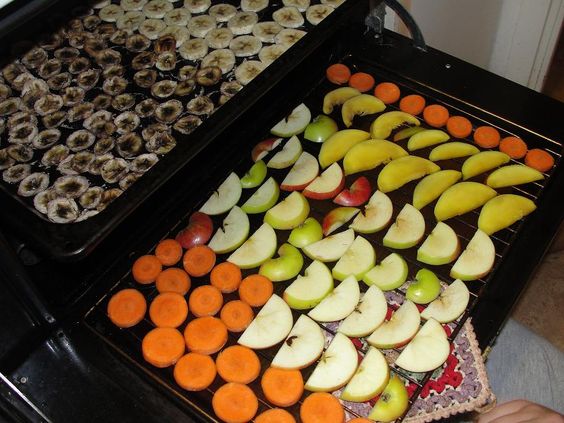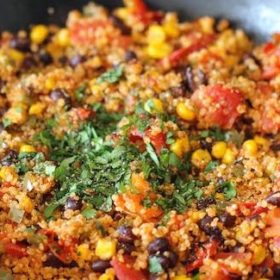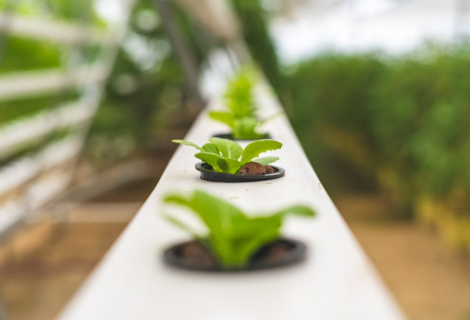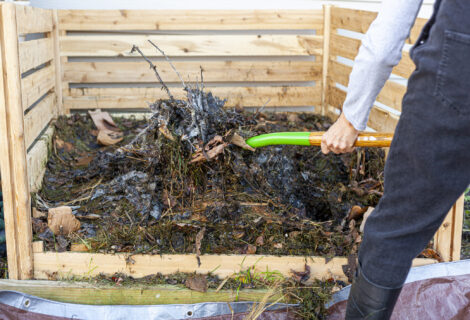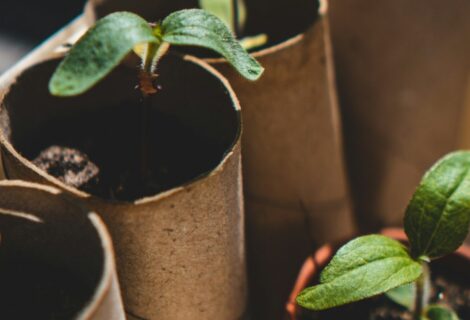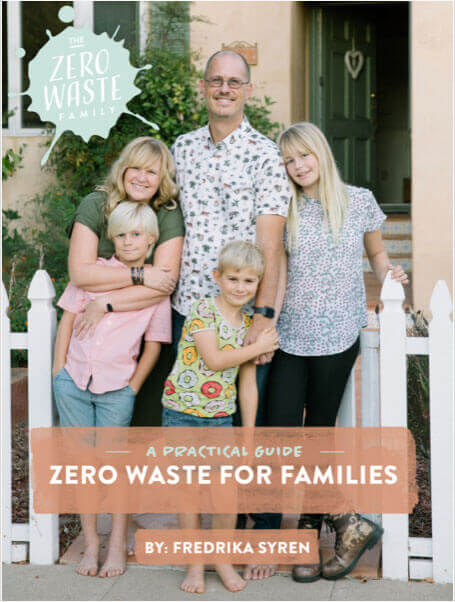Summer’s bounty is just around the corner, and we may find ourselves with far more garden produce than we can consume. Canning is a good option for preserving food, but many people feel intimidated by the whole process. Dehydrating food is an inexpensive and simple way to store excess fruits, veggies, herbs and more.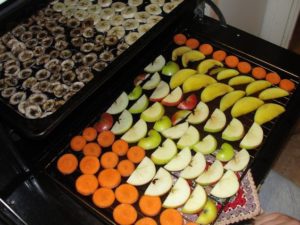
Drying doesn’t require a lot of energy, and it concentrates flavors, magically turning fresh fruits into something like candies. There are three basic methods for dehydrating food:
- Sun-drying:Pro — Uses the smallest carbon footprint; no gas or electricity needed. Con — Requires three to five consecutive days of 95-degree temperatures and low humidity.
- Low oven:Pro — No special equipment needed: simply place sliced fruit or veggie on a baking sheet and set your oven’s temperature to its lowest setting. Con — Uses some gas or electricity; restricts use of oven for six to twelve hours.
- Dehydrator:Pro — Frees up oven; can dehydrate several square feet of food at once in stacked layers; relatively small footprint on countertop. Con — Expensive, plastic, uses electricity. For tips on choosing a food dehydrator, click here.
The possibilities for transforming food through dehydration are endless. Here are a few ideas:
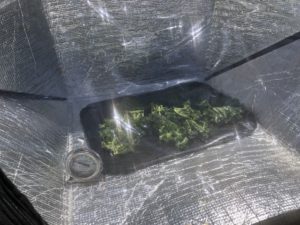 Kale Chips— If you have a kale hater in your home, give them these chips to try. They’re crispy, crunchy, salty and highly addictive. To make them, simply remove the stems and spines, wash and spin-dry the leaves, spread them on a baking sheet, drizzle with olive oil and salt, and bake on low until they’re crisped. Take it a step further with this recipe for Sundried Tomato and Cheezy Kale Chips.
Kale Chips— If you have a kale hater in your home, give them these chips to try. They’re crispy, crunchy, salty and highly addictive. To make them, simply remove the stems and spines, wash and spin-dry the leaves, spread them on a baking sheet, drizzle with olive oil and salt, and bake on low until they’re crisped. Take it a step further with this recipe for Sundried Tomato and Cheezy Kale Chips.
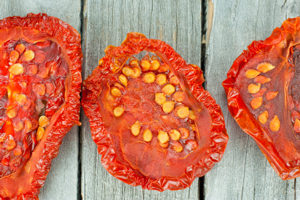 Sun-Dried Tomatoes— Speaking of tomatoes, one way of dealing with a bounty of themis to make sun-dried tomatoes — don’t worry, you can use any drying method. Choose meatier tomatoes like Roma or Beefsteak. Remove cores, then slice in half lengthwise. After that, cut 1-inch-thick wedges. Arrange wedges skin side down, with plenty of room between for air to circulate. Dehydrate at 135 to 145 degrees for six to twelve hours, depending on the tomatoes’ juiciness. Store in an air-tight container. Rehydrate in hot water, or crush and add to soups or stews, or blitz in a processor for tomato powder. Sun-dried tomatoes also can be stored in oil.
Sun-Dried Tomatoes— Speaking of tomatoes, one way of dealing with a bounty of themis to make sun-dried tomatoes — don’t worry, you can use any drying method. Choose meatier tomatoes like Roma or Beefsteak. Remove cores, then slice in half lengthwise. After that, cut 1-inch-thick wedges. Arrange wedges skin side down, with plenty of room between for air to circulate. Dehydrate at 135 to 145 degrees for six to twelve hours, depending on the tomatoes’ juiciness. Store in an air-tight container. Rehydrate in hot water, or crush and add to soups or stews, or blitz in a processor for tomato powder. Sun-dried tomatoes also can be stored in oil.
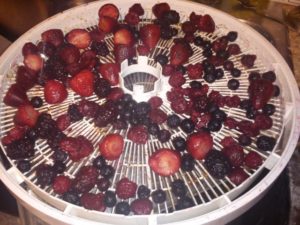 Berries— Four cups of fresh fruit will reduce to about one cup. For strawberries, hull the cores and slice berries lengthwise into thirds. For blueberries, blanch in boiling water for about 30 seconds to tenderize the tough skins, then pat dry and dehydrate whole. For raspberries or blackberries, wash and dry berries thoroughly, then arrange whole in a single layer, spray lightly with lemon juice to keep them from turning brown, and dehydrate at 135 degrees for fifteen to eighteen hours.
Berries— Four cups of fresh fruit will reduce to about one cup. For strawberries, hull the cores and slice berries lengthwise into thirds. For blueberries, blanch in boiling water for about 30 seconds to tenderize the tough skins, then pat dry and dehydrate whole. For raspberries or blackberries, wash and dry berries thoroughly, then arrange whole in a single layer, spray lightly with lemon juice to keep them from turning brown, and dehydrate at 135 degrees for fifteen to eighteen hours.
Mushrooms— Drying mushrooms concentrates their flavor, adding savory umami to any dish. Dried mushrooms can be stored for years; just soak in boiling water to reconstitute them. First, clean mushrooms with a soft brush or damp paper towel. Slice them about 1/8-inch thick and arrange on baking sheet in a single layer. Then cook at 150 degrees for one hour. Remove mushrooms and turn over. Blot any moisture that has sweated out of the mushrooms with paper towels. Cook for another hour. At this point the mushrooms should be completely dried; if not, repeat blotting and baking. Allow to cool, and store in an air-tight container in a cool, dark place. Also, see these tips on foraging for mushrooms, or growing your own at home.
Herbs and Edible Flowers— Got mint or rosemary taking over your garden? Drying herbs is a great way to save them for year-round use. Garnishing salads or desserts with edible flowers adds delightful pops of color. For tips on which flowers are safe to eat and ways to use dried herbs and flowers, click here.
Rose Hips— Speaking of flowers, rose hips are the small, cherry-sized fruit left behind after roses have faded. They have a spicy, nutty, sweet-tart floral flavor, are full of vitamin C; and can be dried and used to make tea, or even eaten straight as a snack, like dried berries. After the roses have died, collect the hips and wash them gently. Cut hips in half and scrape out the hairy seeds. Dry on a baking sheet, checking frequently and stirring often so that they don’t burn. You also can string them on a thread with a needle (leave room between) and hang them in a cool, dry place for a few days. Store in an airtight container. For tea, steep the hips in boiling water, or add them to tisane blends with other herbs like chamomile, hibiscus blossoms, rose petals, elderberries, calendula, or citrus zest.
Citrus Zest— Speaking of citrus zest, you can save the rinds of lemons, limes, oranges, and grapefruits after squeezing their juice and make dehydrated zest. With it, you can make things like citrus powder, citrus extract, citrus sugar, citrus-infused oil, and lemon pepper. Use a microplane or zester to scrape just the outer layer, leaving behind the bitter white pith. Spread zest on parchment paper and dry in a warm, low-moisture area. Store in an airtight container. For more ideas, check out these 20 Uses for Leftover Rinds and Peels.
Banana Chips— Have a bunch of bananas about to turn brown? You could make banana bread, or freeze them for smoothies, but you also could make banana chips (another kid favorite)! To make them, first peel and slice bananas, then spritz with lemon juice to prevent browning. Arrange on a lightly oiled baking sheet in a single layer. Dry in the oven at 175 degrees for two to three hours until crisped and golden. Cool completely and store in airtight containers.
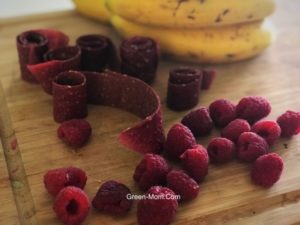 Fruit leather— Kids adorefruit leather, and it can be stored for 30 days at room temperature, for months in the refrigerator, or for years in the freezer. Any type of ripe fruit can be used. Remove pits, stones, seeds, and/or peel. (Option: You can incorporate the peel if desired). Add 1 tablespoon of lemon juice per quart of any fruit that might turn brown. Add sugar to taste (optional), and cook over medium heat until tender. Puree in a blender until smooth. Cover a cookie sheet with parchment paper, then pour out puree until 1/4-inch deep, spreading evenly. Place in oven on lowest setting with oven door cracked open for four to six hours or until dry and the fruit leather is not sticky. You can also make fruit leather from rose hips!
Fruit leather— Kids adorefruit leather, and it can be stored for 30 days at room temperature, for months in the refrigerator, or for years in the freezer. Any type of ripe fruit can be used. Remove pits, stones, seeds, and/or peel. (Option: You can incorporate the peel if desired). Add 1 tablespoon of lemon juice per quart of any fruit that might turn brown. Add sugar to taste (optional), and cook over medium heat until tender. Puree in a blender until smooth. Cover a cookie sheet with parchment paper, then pour out puree until 1/4-inch deep, spreading evenly. Place in oven on lowest setting with oven door cracked open for four to six hours or until dry and the fruit leather is not sticky. You can also make fruit leather from rose hips!



